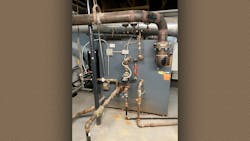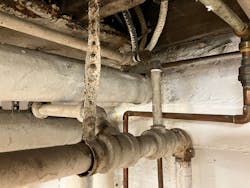Recently, the photos that accompany the columns haven’t been matching up as well as I like, and since “it’s all about me,” I wanted to make sure I took some job site photos to use for this column. It was time for a column about steam and I hadn’t written about an important component of the near boiler piping for steam boilers yet.
A call came in to look at a steam job—my opportunity to get the shots. This steam boiler heats forty-six cast iron radiators. The building owner’s “consultant” had a list, with each size. The first floor is an art gallery and workshop, while the upper three floors are apartments.
(The first floor used to be the paint store I used for years—it looked a lot different with art on the walls.)
The contractor, the consultant and I went down to the boiler room, which is in the middle of the basement. Immediately, I realized this boiler wasn’t photo ready as a good example of how to pipe a steam boiler. Then I figured that a bad example can teach a thing or two also.
The Hartford Loop
By now, if you’re looking at the photo of the side of the boiler and you know just a little bit about how to pipe one, you’ve noticed that there isn’t a Hartford Loop. Every steam boiler installation guide I have seen during the past 40 years, no matter the manufacturer, shows a Hartford Loop as part of the near boiler piping.
Yes, the Hartford Loop was developed by the Hartford Insurance Company. Why would an insurance company get involved with steam boiler piping? To avoid paying out money, of course. Steam boilers that they insured were exploding, which wasn’t good for business. This is back in the early days of coal-fired steam boilers, without reliable water level control since everything was manually controlled.
If you put water into an empty steam boiler that is hot, that water instantly expands to 1700 times its volume. The boiler then might launch itself out of the building to land in the front yard. Exciting, but a very dangerous don’t-try-this-at-home kinda thing. The water usually leaked out of the boiler from a leak in a low wet return line.
How it Works
The main function of the loop is to keep water in the boiler, which prevents dry-firing and boiler explosions. Another function of the loop is to equalize the pressure on both the supply side and return side of the water in the boiler, so the build-up of pressure felt on the waterline doesn’t just push the water out of the boiler.
With the steam pressure building up in the boiler felt on the return side, water stays where it supposed to be, generating steam to heat the building. As you can see in the photo, there is no connection between the large supply pipe leaving the top of the boiler and the smaller return pipe heading straight into the bottom of the boiler.
The Hartford Insurance Company wouldn’t approve of this piping arrangement, nor would the boiler manufacturer or the city inspector. (To get more information on the Hartford Loop, go to pages 102 and 103 of my Field Guide, available as a free download at steamupairoutwaterback.com. Information should be shared, like Ben Franklin suggested.)
An early attempt to keep the water in the boiler was a swing check valve. Water returning to the boiler swings the flapper open to allow water to flow into the boiler. During the off cycle, the flapper prevents the boiler water from flowing the opposite way out of the boiler. Unfortunately, a check valve in a wet return, given the nature of the junk/rust/muck in the bottom of a steam system, quickly sticks open or clogs up. Always go with the Loop.
Worse the More You Look
To add insult to injury, take a look at the other photo. This is a two-pipe steam system, meaning it has both supply mains and return mains. The county auditor’s website says the building has been around since 1929, during the Golden Age of Steam. A two-pipe system from this era removed the air from the entire system at one location in the boiler room, which makes perfect sense to me.
The air in the steam supply main passes through a steam trap to the dry return, which carries the air back to the boiler room at ceiling height. That’s the far end of one of four dry returns in the other photo. The condensate from the radiators flows along the bottom of the pipe to the elbow that points down, which connects to the wet return to carry the water back to the boiler.
Originally, there was a trap between the two ½” caps. Now, there isn’t a path for the air from the end of the steam mains to get out of the way of the steam. This causes uneven heat in the building. Looking around the boiler room, I found that the original main air vent had been removed. No place for the air to get out even if the trap was there. Funny things happen to steam systems over 94 years.
The consultant said the only complaint was the first floor got too hot. The air probably gets pushed by the steam to the top floor radiators and gets stuck, blocking the flow of steam into the top floor radiators, overheating the first floor. I said air venting would also have to be corrected if the new boiler wanted a chance of heating evenly.
Always take a look around the building. On occasion, you’ll be surprised at what’s there and what’s not there.
Patrick Linhardt is a forty-year veteran of the wholesale side of the hydronic industry who has been designing and troubleshooting steam and hot water heating systems, pumps and controls on an almost daily basis. An educator and author, he is currently Hydronic Manager at the Corken Steel Products Co.
About the Author
Patrick Linhardt
Patrick Linhardt is a forty-one-year veteran of the wholesale side of the hydronic industry who has been designing and troubleshooting steam and hot water heating systems, pumps and controls on an almost daily basis. An educator and author, he is currently Hydronic Manager at the Corken Steel Products Co.

